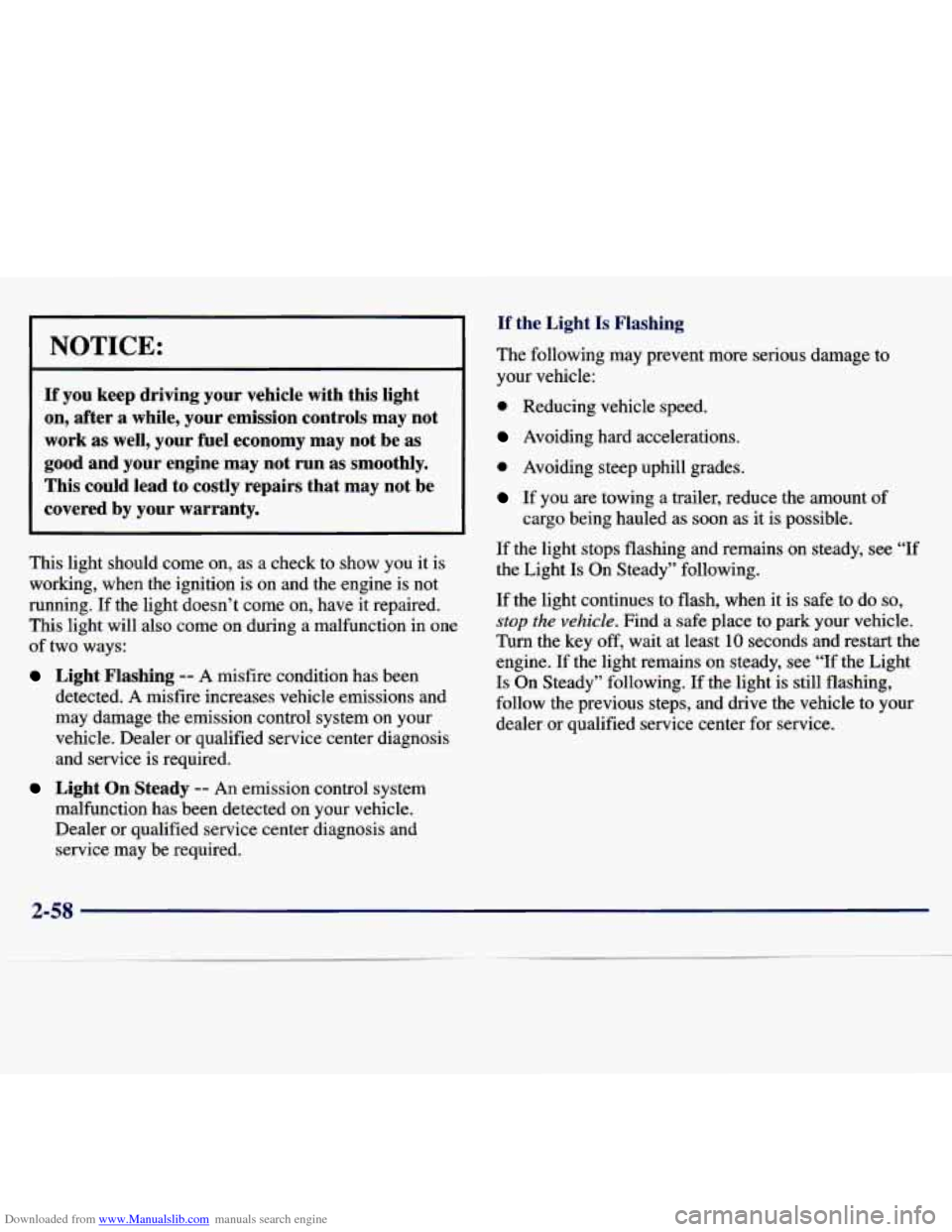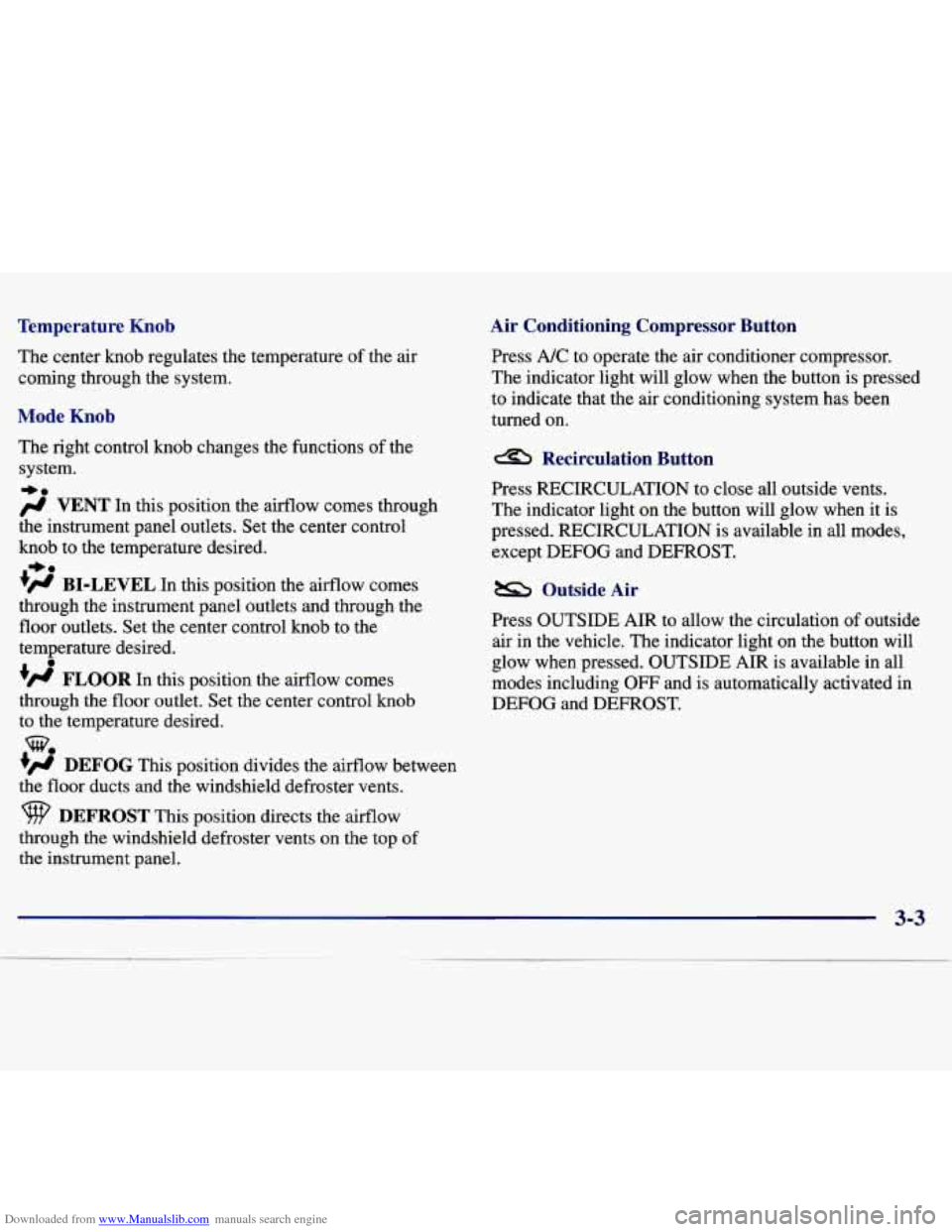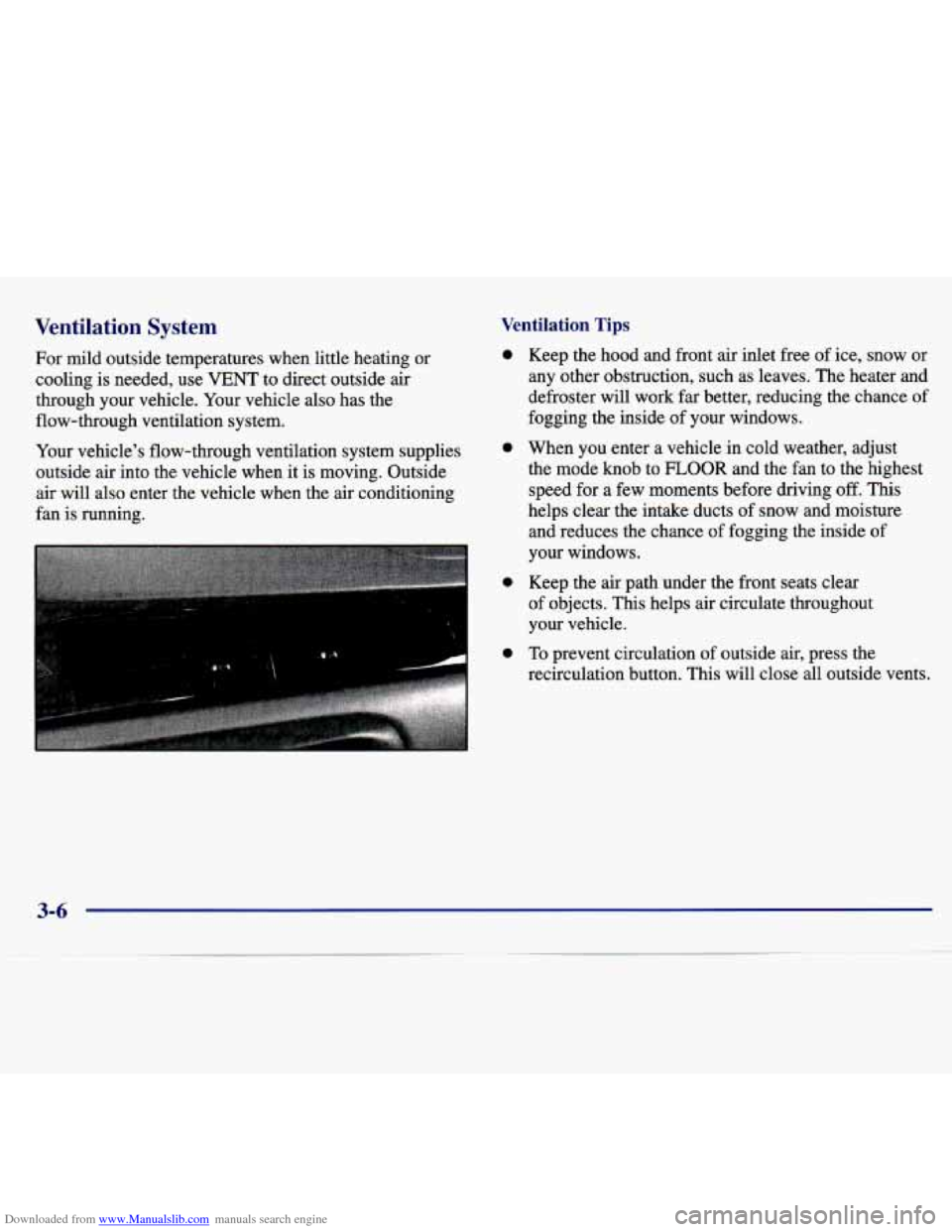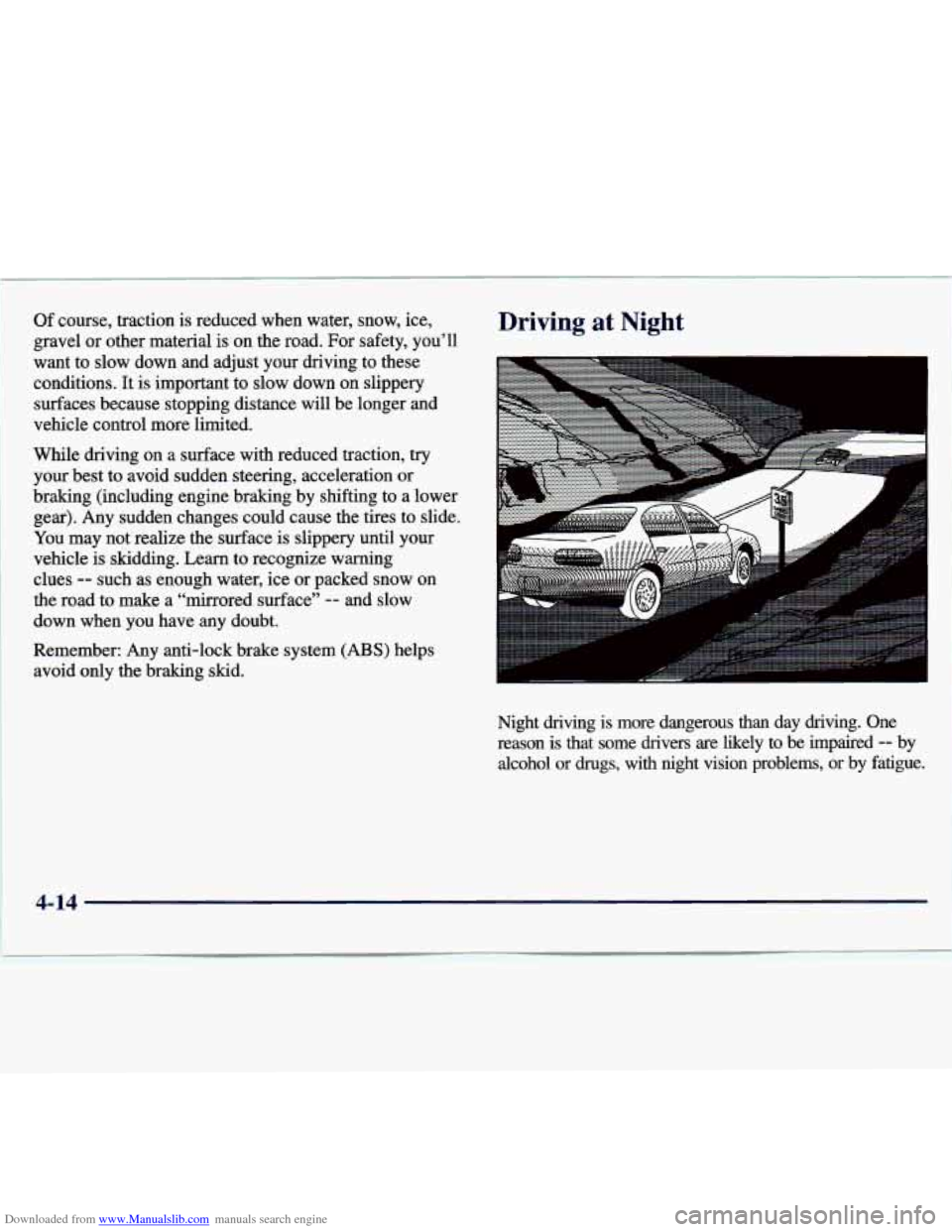1997 CHEVROLET MALIBU air condition
[x] Cancel search: air conditionPage 111 of 354

Downloaded from www.Manualslib.com manuals search engine Air Bag Readiness Light
There is an air bag readiness light on the instrument
panel, which shows the air bag symbol. The system
checks the air bag’s electrical system for malfunctions.
The light tells you if there is an electrical problem. The
system check includes the air bag sensor, the air bag
modules, the wiring and the crash sensing and
diagnostic module. For more information on the air bag
system, see “Air Bag” in the Index.
This light will. come
on
~ when you start your engine,
and it will flash for a few
seconds. Then the light
should go out. This means
the system is ready.
If the air bag readiness light stays on after you start the
engine or comes on when you are driving, your air bag
system may not work properly. Have your vehicle
serviced right away. The
air bag readiness light should flash for a few
seconds when you turn the ignition key to
ON. If the
light doesn’t come on then, have it fixed
so it will be
ready to warn you if there is a problem.
Charging System Indicator Light
The charging system
indicator light will come on
when you turn on the ignition, but the engine
is
not running, as a check to show you
it is working.
Then it should go out.
If it stays on,
or comes on while yoa aye- driving and you
hear
a chime, you may have a problem with the
electrical charging system. It could indicate that you
have a loose generator drive belt or another electrical
problem. Have it checked right away. Driving while this
light is on could drain your battery.
If you must drive a short distance with the light on, be
certain to
turn off all your accessories, such as the radio
and air conditioner.
2-54
Page 115 of 354

Downloaded from www.Manualslib.com manuals search engine NOTICE:
If you keep driving your vehicle with this light
on, after a while, your emission controls may not
work as
well, your fuel economy may not be as
good and your engine may not run as smoothly.
This could lead to costly repairs that may not be
covered by your warranty. If the Light
Is Flashing
The following may prevent more serious damage
to
your vehicle:
0 Reducing vehicle speed.
Avoiding hard accelerations.
0 Avoiding steep uphill grades.
If you are towing a trailer, reduce the amount of cargo being hauled as soon as it is possible.
If the light stops flashing and remains on steady, see “If
the Light
Is On Steady” following.
If the light continues to flash, when it
is safe to do so,
stop the vehick. Find a safe place to park your vehicle.
Turn the key
off, wait at least 10 seconds and restart the
engine. If the light remains on steady, see “If the Light
Is On Steady” following. If the light is still flashing,
follow the previous steps, and drive the vehicle to your dealer or qualified service center for service.
This
light should come on, as a check to show you
it is
working, when the ignition is on and the engine is not
running. If the light doesn’t come on, have it repaired.
This light will
also come on during a malfunction in one
of two ways:
Light Flashing -- A misfire condition has been
detected. A misfire increases vehicle emissions and
may damage the emission control system on your
vehicle. Dealer or qualified service center diagnosis and service is required.
Light On Steady -- An emission control system
malfunction has been detected on your vehicle.
Dealer or qualified service center diagnosis and service may be required.
2-58
Page 122 of 354

Downloaded from www.Manualslib.com manuals search engine U Section 3 Comfort Controls and Audio Systems
In this section, you'll find out how to operate the comfort control and audio systems offered with your Chevrolet. Be
sure to read about the particular systems supplied with your vehicle.
3-2
3-2
3-4
3-4
3-5
3-6
3-7
3-7
3-9 3-13 Climate Controls
Air Conditioning
Heating
Tips for Defogging and Defrosting
Rear Window Defogger
Ventilation System and Tips Setting the Clock
A" Stereo
A" Stereo with Cassette and ATC
CD Adapter Kits
3- 14
3-18
3- 19
3-22
3-22
3-22 3-23
3-24
3-24 A" Stereo with CD and ATC
Remote Cassette Player
Theft-Deterrent Feature
Adding Sound Equipment to Your Vehicle
Understanding Radio Reception Tips About Your Audio System
Care of Your Cassette Tape Player
Care of Your Compact Discs
Antenna
3-1
Page 123 of 354

Downloaded from www.Manualslib.com manuals search engine Comfort Controls
This section tells you how to make your air system
work for you. The climate control system with air
conditioning uses ozone-friendly
R- 134a refrigerant.
With these systems, you can control the ventilation and heating in your vehicle. Your vehicle also has
the flow-through ventilation system described later
in this section.
Climate Control System with
Air Conditioning
8 Fan Knob
The left knob selects the force of air you want. Turn the
knob to the right to increase fan speed and
to the left to
decrease fan speed. To
turn the fan off (which will also
turn the climate control system
off), turn the knob all the
way to the left. In any other setting, the fan will run
continuously. The fan must be
on to run the air
conditioning compressor.
3-2
Page 124 of 354

Downloaded from www.Manualslib.com manuals search engine Temperature Knob
The center knob regulates the temperature of the air
coming through the system.
Mode Knob
The right control knob changes the functions of the
system.
-0
/J VENT In this position the airflow comes through
the instrument panel outlets. Set the center control
knob to the temperature desired.
*H BI-LEVEL In this position the airflow comes
through the instrument panel outlets and through the
floor outlets. Set the center control knob to the
temperature desired.
+’ FLOOR In this position the airflow comes
through the floor outlet. Set the center control
knob
to the temperature desired.
+H DEFOG This position divides the airflow between
the floor ducts and the windshield defroster vents.
DEFROST This position directs the airflow
+o
e
we
through the windshield defroster vents on the top of
the instrument panel.
Air Conditioning Compressor Button
Press A/C to operate the air conditioner compressor.
The indicator light will glow when the button is pressed
to indicate that the air conditioning system has been
turned on.
Recirculation Button
Press RECIRCULATION to close all outside vents.
The indicator light on the button will glow when it is
pressed. RECIRCULATION is available in all modes,
except DEFOG and DEFROST.
Outside Air
Press OUTSIDE AIR to allow the circulation of outside
air in the vehicle. The indicator light on the button will
glow when pressed. OUTSIDE AIR is available in all
modes including
OFF and is automatically activated in
DEFOG and DEFROST.
3-3
Page 125 of 354

Downloaded from www.Manualslib.com manuals search engine Air Conditioning Heating
On cold
days, use FLOOR with the temperature knob
all the way in the red area. The system will bring in
outside air, heat it and send it to the floor ducts.
The
air conditioner and heater work best if you keep
your windows closed while using them. Your vehicle also has the flow-through ventilation system described
later in this section.
On very hot days, open the windows long enough to
let hot inside air escape. This reduces the time it takes
for your vehicle to cool down, which should help
fuel economy.
On cool, but sunny days, the sun may warm your upper
body, but your lower body may not be
warm enough.
You can use
BI-LEVEL with the temperature knob in
the middle and the A/C button pushed in. The system
will bring in outside air and direct slightly warmer air
to your lower body.
For quick cool-down on very hot days, use
VENT with
the temperature knob all the way in the blue area and the
A/C and RECIRCULATION buttons pressed. If this
setting is used for long periods of time, the air in your
vehicle may become too dry.
For normal cooling on hot days, use
VENT with the
temperature knob in the blue area and the
NC button
pushed
in. The system will bring in outside air and cool it.
Your vehicle has heat ducts that are directed toward the
rear seat. Keep the area under the front seats clear
of
obstructions so the heated air can reach the rear seat
passengers.
If your vehicle has an engine coolant heater, you can use it to help your system provide warm air faster when it’s
cold outside
(0°F (-18°C) or lower). An engine coolant
heater warms the coolant your engine and heating system use to provide heat. See “Engine Coolant
Heater” in the Index.
Defogging and Defrosting Windows
Your system has two settings for clearing the front and
side windows. For each setting, adjust the temperature
control as desired.
To defrost the windows quickly, rotate the temperature control knob
all the way in the red area. Use DEFROST
and adjust the fan to the highest speed. To warm
passengers while keeping the windows clean, use DEFOG.
3-4
Page 127 of 354

Downloaded from www.Manualslib.com manuals search engine Ventilation System Ventilation Tips
For mild outside temperatures when little heating or
cooling is needed, use VENT to direct outside
air
through your vehicle. Your vehicle also has the
flow-through ventilation system.
Your vehicle’s flow-through ventilation system supplies
outside air into the vehicle when
it is moving. Outside
air will also enter the vehicle when the air conditioning
fan
is running.
0
0
0
0
Keep the hood and front air inlet free of ice, snow or
any other obstruction, such as leaves. The heater and
defroster will work far better, reducing
. : chance of
fogging the inside of your windows.
When you enter a vehicle in cold weather, adjust the mode
knob to FLOOR and the fan to the highest
speed for a few moments before driving
off. This
helps clear the intake ducts of snow and moisture
and reduces the chance
of fogging the inside of
your windows.
Keep the air path under the front seats clear
of objects.
This helps air circulate throughout
your vehicle.
To prevent circulation of outside air, press the
recirculation button. This will close all outside vents.
3-6
Page 161 of 354

Downloaded from www.Manualslib.com manuals search engine Of course, traction is reduced when water, snow, ice,
gravel or other material is on the road. For safety, you’ll
want to slow down and adjust your driving to these
conditions. It is important
to slow down on slippery
surfaces because stopping distance will be longer and
vehicle control more limited.
While driving on a surface with reduced traction, try your best to avoid sudden steering, acceleration or
braking (including engine braking by shifting to a lower
gear). Any sudden changes could cause the tires to slide.
You may not realize the surface is slippery until your
vehicle is skidding. Learn to recognize warning
clues
-- such as enough water, ice or packed snow on
the road to make a “mirrored surface”
-- and slow
down when you have any doubt.
Remember: Any anti-lock brake system
(ABS) helps
avoid only the braking skid.
Driving at Night
r%?m . ... . . . .. . . . . . . . . . . . . . . . . . . . . . . .
..~ ....... . . . . . . . . . . . . . . . . ........ ...... . . .. . . .. . . .. . .. . .
Night driving is more dangerous than day driving. One
reason
is that some drivers are likely to be impaired -- by
alcohol or drugs, with night vision problems, or by fatigue.
4-14